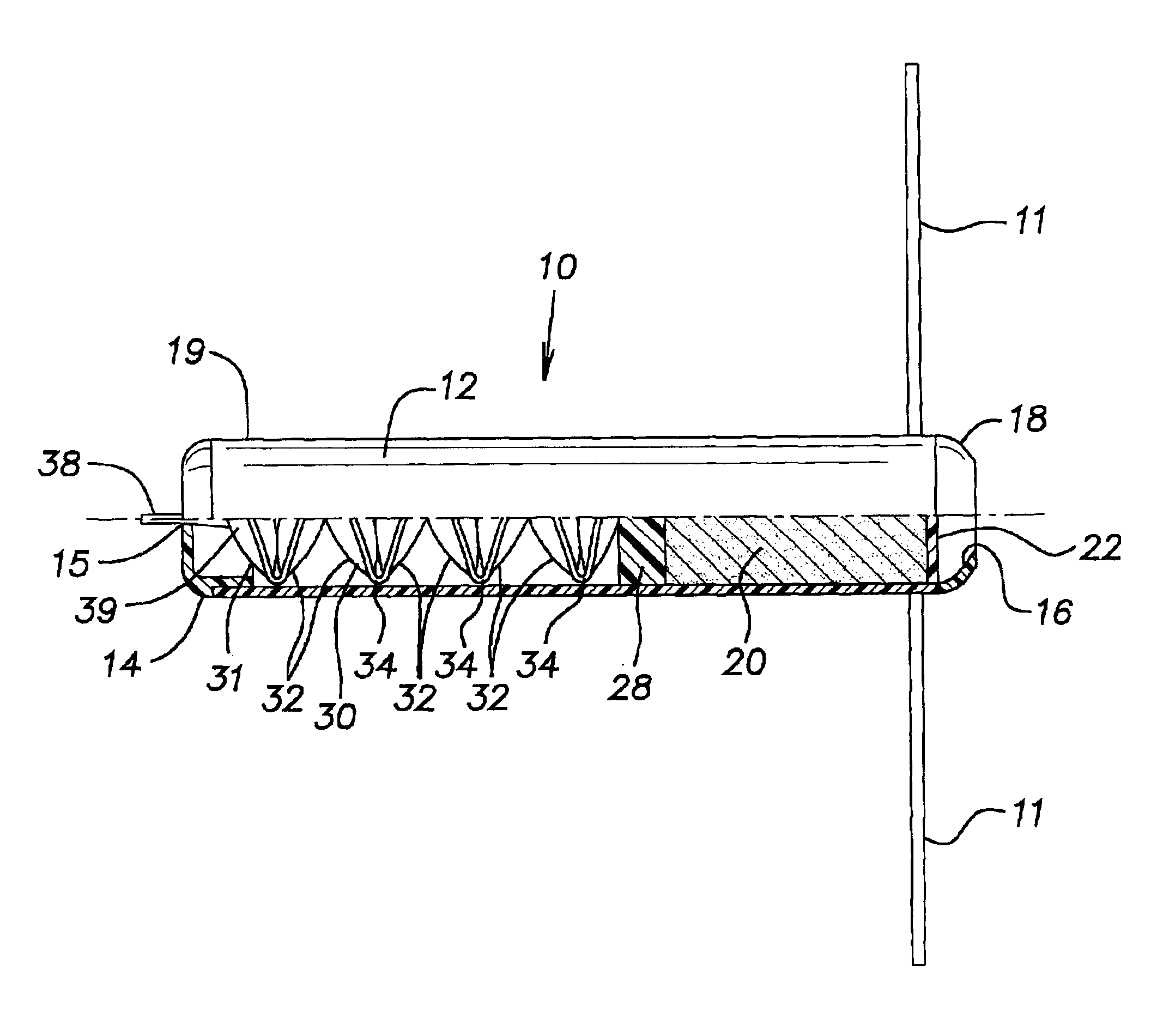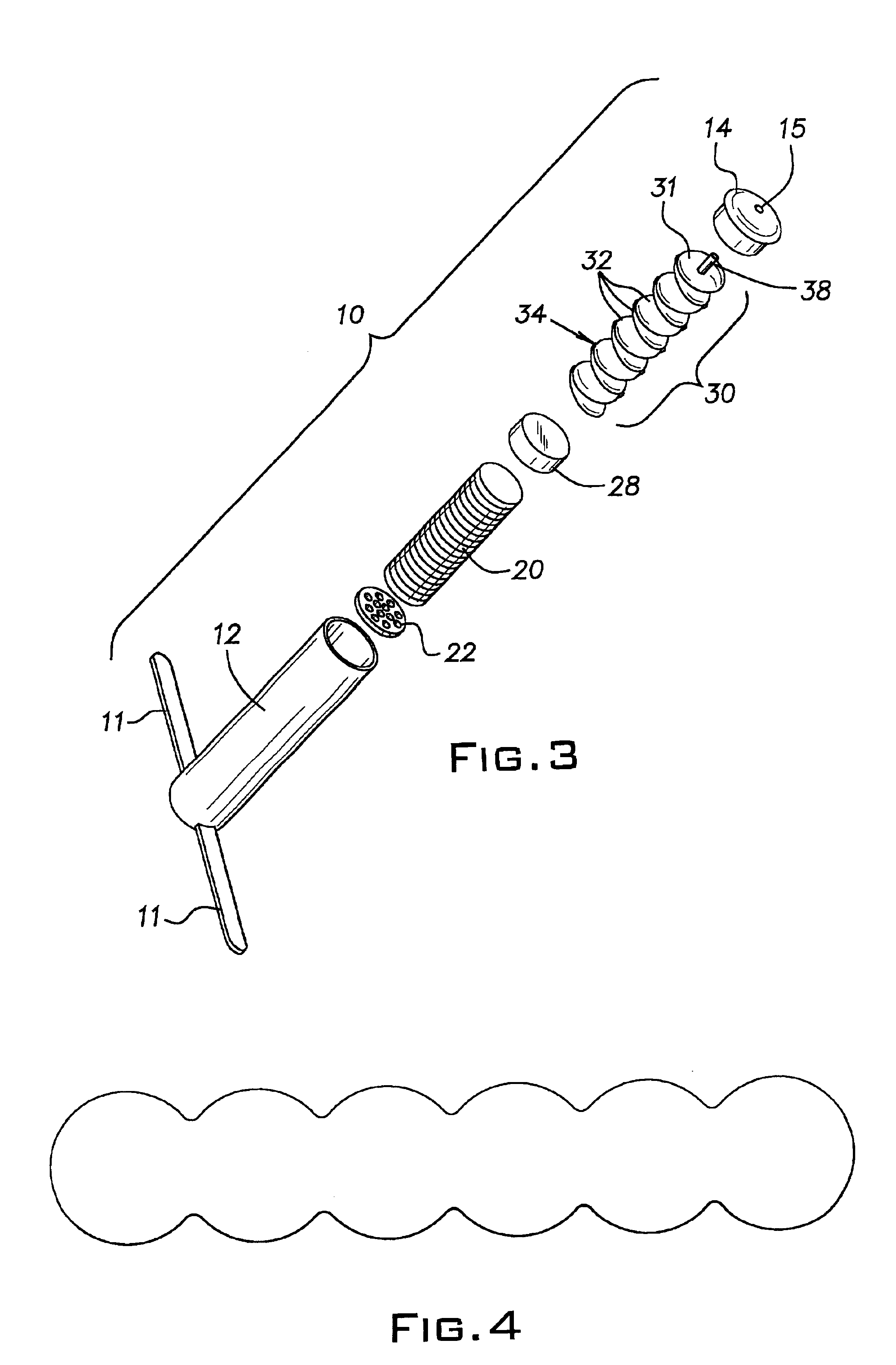Intraruminal device
a technology of ruminant and spleen, which is applied in the field of intraruminal devices, can solve the problems of affecting the health or weight of ruminants, losing weight, and ruminants being also susceptible to infection
- Summary
- Abstract
- Description
- Claims
- Application Information
AI Technical Summary
Benefits of technology
Problems solved by technology
Method used
Image
Examples
first embodiment
[0023]Referring now to FIG. 2, the invention is shown. The device is substantially similar to the device shown in FIG. 1 and described above, except that metal spring 50 has been replaced with bladder assembly 30. Bladder assembly 30 has a leading fluid bladder 31 and a number of subsequent fluid bladders 32 connected in series via bladder passageways 34. Passageways 34 provide fluid communication between all of the bladders 31,32 in the bladder assembly 30. Leading bladder 31 has a fluid delivery tube 38 for inflation or pressurization of the bladder assembly with a pressurizing fluid. Delivery tube 38 has a check valve 39 or other means of retaining fluid pressure therein. The check valve permits a pressurizing fluid to pass from a fluid source through tube 38 into the leading bladder 31 but not in the reverse direction from the leading bladder 31 to the outside. Check valve 39 has a cracking pressure of preferably at least 0.1, more preferably at least 0.5 psid.
[0024]Bladder asse...
third embodiment
[0037]Referring now to FIGS. 8 and 9, a bladder assembly 50 for use in an intraruminal device is shown. The bladder assembly 50 has a leading fluid bladder 31 and at least one fluid bladder 32. The fluid bladders communicate with each other through bladder passageways 34. Bladder assembly 50 has a fluid delivery tube 38 and a check valve 39 (not shown). FIG. 8 shows the bladder assembly in a compressed configuration, while FIG. 9 shows the bladder assembly in an expanded configuration. In this embodiment the fluid bladders are essentially centrally located along an axis passing through the plurality of bladders, allowing expansion or contraction like an accordion.
[0038]When bladder assembly 50 is put in intraruminal device 10 or 44 and inflated, each individual fluid bladder 31,32 will tend to inflate, driving the bladder assembly 50 away from the collapsed configuration shown in FIG. 8 toward the expanded configuration shown in FIG. 9. As the bladder assembly tends toward the expan...
fourth embodiment
[0040]In the invention, no bladder assembly is used. A plunger or piston 28 is placed in the housing. The plunger or piston can slide along the length of the housing and creates a fluid-tight seal against the inner surface of the housing. A means for retaining fluid pressure is built into the device, either by molding or by insertion. The fluid pressure retention means may be located in the cap 14. After loading the device with medicament and prior to insertion of the intraruminal device, the region between the second end and the piston is pressurized with fluid to an initial pressure of at least 1, preferably 10, preferably 20, preferably 30, preferably 35, preferably 50 psig. The fluid pressure drives the piston against the medicament, forcing the medicament toward the first end of the device.
[0041]The medicament within the matrix to be dispensed by the invented device can be any known medicament suitable for time release dispensation that can be dispersed in a matrix. Suitable me...
PUM
 Login to View More
Login to View More Abstract
Description
Claims
Application Information
 Login to View More
Login to View More - R&D
- Intellectual Property
- Life Sciences
- Materials
- Tech Scout
- Unparalleled Data Quality
- Higher Quality Content
- 60% Fewer Hallucinations
Browse by: Latest US Patents, China's latest patents, Technical Efficacy Thesaurus, Application Domain, Technology Topic, Popular Technical Reports.
© 2025 PatSnap. All rights reserved.Legal|Privacy policy|Modern Slavery Act Transparency Statement|Sitemap|About US| Contact US: help@patsnap.com



